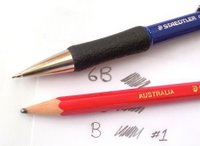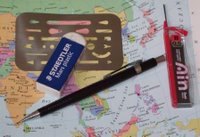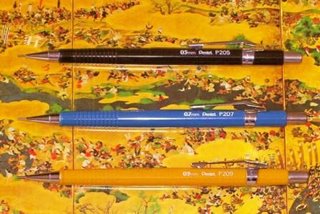 With three European heavyweights and a respected, but lesser known Japanese competitor filling out the numbers, Pool B was expected to be hotly contended. And what a contest it was. By the time play finished the crowds were exhausted.
With three European heavyweights and a respected, but lesser known Japanese competitor filling out the numbers, Pool B was expected to be hotly contended. And what a contest it was. By the time play finished the crowds were exhausted.Competition see-sawed back and forth. Spectators were surprised at Germany’s Faber-Castell placing last in the opening event, the blackness contest, but defeat spurred Faber-Castell on, giving them crushing victories in the next two events, smear resistance and erasability. The other three competitors were constantly jockeying for position, snapping at Faber-Castell’s heals.
The strength test is always the most important event, but with all four competitors so close, it was going to be a thrilling finale. Who would have believed it, from nowhere Zebra grabbed the lead, charging past the others as if they weren’t even there. Faber-Castell crashed to an unbelievable last placing in the strength test. The fans were agitated and organisers put the riot police on stand-by. Luckily calm prevailed, and the crowds dissipated, stunned by the events they had witnessed.
The individual event placings were, from first place to fourth:
Blackness – Rotring, Zebra & Waterman (2=), Faber-Castell.
Smear Resistance – Faber-Castell, Rotring, Zebra, Waterman.
Erasability – Faber-Castell, Waterman, Rotring, Zebra.
Strength – Zebra, Waterman, Rotring, Faber-Castell.
So with an overall score of 11, Zebra from Japan narrowly snatched victory from Germany’s Rotring and France’s Waterman, who were both on 12. With 14 points, Faber-Castell finished last, a placing which will be talked about for years to come.
The bookmakers’ odds are being re-written as people start to consider the possibilities of Pool C. Could a heavyweight like Mont Blanc also stumble to last place? Could a little known Asian like Micro from Korea pull a similarly stunning victory out of the bag? The results will be in soon enough.
SOME RESULTS DETAIL

So, here's a little snippet from the individual competitons. The photo shows some parts of the tests. On top row is part of the Blackness test and the next two rows are from the eraseability tests. It's interesting on the bottom row of heavy penciling, how differently the various leads react to a light swipe of the eraser. I guess it's an effect of the amount of carbon black and wax / oil in the lead - some like the F-C erase well, others like the Rotring and Zebra just immediately coat the surface of the eraser and then it just slides on over smearing and / or not erasing as it goes. Of course they all actually erase fairly well if you give them a good scrubbing. I think in the finals I will consider introducing several different eraser compounds - rubber, vinyl and vinyl-free plastic.
Also for the final there will be a bit more information and review of the finalists.
Rain Interrupts Play
Sorry sports-fans, but rain has interrupted play. Either that or I'm off on holiday. Anyway, I will be absent from the blogosphere for a couple of weeks.
















 Plastic injection moulds are very expensive things. Germany’s Staedtler obviously decided there was no need to make new moulds when they could update their look with a new label and a change from opaque blue to a more modern looking transparent plastic.
Plastic injection moulds are very expensive things. Germany’s Staedtler obviously decided there was no need to make new moulds when they could update their look with a new label and a change from opaque blue to a more modern looking transparent plastic.














